#1970s Closure
Explore tagged Tumblr posts
Text
Overland Hotel and Casino - Reno, Nevada
The Overland Hotel and Casino, a renowned name in Reno’s chip-collecting community, holds a unique place in the history of legalized gaming in Nevada. Established in 1933, it stands as one of the state’s earliest legal gaming establishments, following the legalization of gaming in Nevada in 1931. Under the ownership and vision of Richard “Pick” Hobson, a pioneering figure in Reno’s gaming scene,…
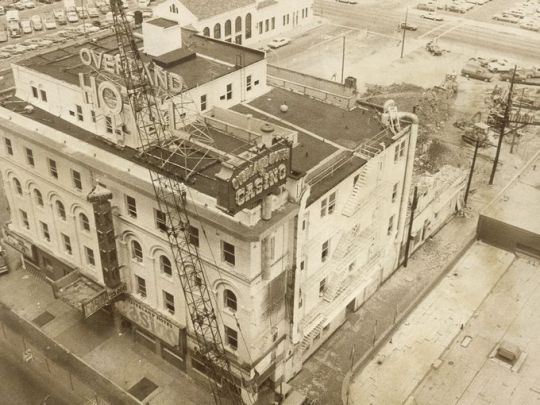
View On WordPress
#1930s Gaming#1948 Reconstruction#1970s Closure#20th Century History#Antique Ashtrays#Bill Brown#Bowling Alley#Brick Construction#Brick Facades#Building Materials#Building Restoration#Casino Collectibles#Casino History#Casino Memorabilia#Casino Owners#Cherry Wood Bar#Chinese Heritage#Chinese-Owned Property#Clean Operations#Coffee Shop#Coffee Shop Addition#Concrete Construction#Cowboy Art#Cowboy Legacy#Dance Hall#Dance Hall Transformation#Doctor&039;s Clinics#Doctor&039;s Offices#Early Gaming#Employee Payments
0 notes
Text


I rlly wanna start posting some sewing patterns from my fashion Pinterest boards on here!! Starting off with some adorable 70s McCall’s sets in my favorite colors :-)
#Will tag them under#Ellie’s fashion faves#I will probably post more than just sewing patterns on here! probably some magazine ads & potentially my own fashion journal!!#and for those in the know…these are SO Irene coded#they’re on my board for her#I got a 70s waistcoat pattern today and I rlly wanna do those cute closures from the first pattern here!!!!#1970s#70s fashion#sewing patterns#McCalls#orange
14 notes
·
View notes
Text
pacing around wondering if I'll hear back from a job despite it being the dead of night
#oxbow.txt#I'm stress sewing a circa 1970 bra#well I copied a pattern from a complete bra pattern I own and am comparing it to extant examples#the ones closest to what I'm working with are all from the USSR???#anyway I need to buy two kinds of elastic and decide on fasteners#anyone in this chat used a bikini clasp? do they stay on?#asking because this demands an obscure form of closure (single elastic bra hook) that no longer exists#so I'd need a French bra back as Mrs Depew calls them#either that or I could try using the slight mechanical stretch across the band but that's not how it's done with wovens#or I could sew a hook and eye to the elastic like the directions say but hellll no#I'd rather do a button and loop at that point
3 notes
·
View notes
Text



On This Day: Kent State shootings leave 4 students dead!
Four Kent State University students were killed and nine were injured on May 4, 1970, when members of the Ohio National Guard opened fire on a crowd gathered to protest the Vietnam War. The tragedy was a watershed moment for a nation divided by the conflict in Southeast Asia. In its immediate aftermath, a student-led strike forced the temporary closure of colleges and universities across the country. Some political observers believe the events of that day in northeast Ohio tilted public opinion against the war and may have contributed to the downfall of President Richard Nixon.
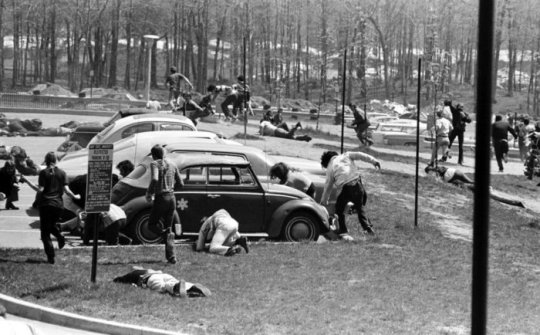
Students dive to the ground as the National Guard fires on faculty and students May 4, 1970, to protest the war in Vietnam. File Photo courtesy of Kent State University Archives
The Kent State Shootings
“… Give Peace a Chance (iastate.edu)
On This Day, May 4: Kent State shootings leave 4 students dead - UPI.com
#فلسطين#امريكا#الشرطة#vietnam war#kent state#university#student protest#UCLA#columbia university#on this day#MAY#may the fourth be with you#the amazing digital circus#HISTORY#1970S#vintage#1970s history#USA#richard nixon#KENT STATE#university protests#protests#columbia#palestine protest#boycott israel#gaza#Palestine#free gaza#free palestine#art
465 notes
·
View notes
Text
• Elvis & The Rise of the Nautic Sunglasses •
I randomly had a thought the other day and somehow fell down a rabbit hole of researching when Elvis began wearing his famous sunglasses that everyone knows and loves, so here’s some interesting information I discovered! Enjoy ~ ♡


January 16th, 1971 in Memphis, TN for the Jaycees' 10 Outstanding Men of America award ceremony.
The Nautic style frames of sunglasses were made popular in the 70s through the German company ‘Neostyle’ and were created by head designer Konstantin Livas. Along with Elvis, other famous celebrities such as Ray Charles, Telly Savalas, and Don King wore the stylish frames, making them a staple of 1970’s fashion.
Elvis first seemed to discover the sunglasses in 1970 when visiting his optician ‘Optique Boutique’ on Sunset Boulevard. The shop owner, Dennis Roberts, brought out a pair of sunglasses for Elvis to try on, specifying that he should wear a pair that covered his eyebrows since it was one of the most important parts to consider when purchasing a pair of shades. He loved the sunglasses so much that he ordered five pairs of the Nautic 2 style, and three more pairs with solid gold frames (in typical Elvis fashion).
After searching through various photos from 1970, it seems like Elvis began wearing the Nautic style sunglasses sometime in July of that year. From what I can tell, they make their first appearance while Elvis is in Culver City at the MGM lot working on his new upcoming concert documentary: 'That's the Way it Is'.


July 15th, 1970 in Culver City, CA at the MGM lot for the reheresals and filming of That's the Way It Is.
Curiously enough, the famous ‘EP’ and ‘TCB’ insignia didn’t appear until December of 1970. The first appearance of the customized sunglasses looked to be at George Klein’s wedding on December 5th, 1970, with its previous appearances being the classic Nautic style without the insignia.
It is to be noted, however, that Elvis would go on to wear the two styles interchangeably over the next several years.


December 5th, 1970, at George Klein's wedding, where Elvis was serving as his best man.
At first, the sunglasses seemed to be a stylistic choice by Elvis, but in September of 1970, Elvis was diagnosed with iritis (anterior uveitis) which is the most common type of inflammation of the iris and can cause redness, pain, light sensitivity, blurred vision, and dark floating spots in the field of vision. Just a few months later in March of 1971, he would suffer from acute angle closure glaucoma while in Nashville at RCA Studio B. He was immediately treated at the nearby Nashville Baptist Hospital by Dr David Meyer. During his stay and after some initial testing, he would officially be diagnosed with secondary glaucoma.


Elvis leaving his ophthalmologist's office in Beverly Hills, November 27th, 1971.
While sunglasses had always been a part of Elvis’ fashion in the past, according to Elvis himself (and many of those around him), he would continue to wear the Nautic sunglasses to help shield his eyes from the bright lights on stage and also the flashing lights that came from the cameras.
"𝘓𝘢𝘵𝘦𝘳, 𝘩𝘦 𝘸𝘩𝘪𝘱𝘱𝘦𝘥 𝘰𝘶𝘵 𝘢 𝘨𝘪𝘢𝘯𝘵 s𝘶𝘪𝘵𝘤𝘢𝘴𝘦 𝘢𝘯𝘥 𝘵𝘩𝘳𝘦𝘸 𝘪𝘵 𝘰𝘯𝘵𝘰 𝘵𝘩𝘦 𝘣𝘢𝘵𝘩𝘳𝘰𝘰𝘮 𝘤𝘰𝘶𝘯𝘵𝘦𝘳. "𝘔𝘺 𝘎𝘰𝘥!" 𝘐 𝘦𝘹𝘤𝘭𝘢𝘪𝘮𝘦𝘥, 𝘢𝘴 𝘩𝘦 𝘦𝘹𝘤𝘪𝘵𝘦𝘥𝘭𝘺 𝘶𝘯𝘤𝘭𝘢𝘴𝘱𝘦𝘥 𝘵𝘩𝘦 𝘤𝘢𝘴𝘦, 𝘴𝘱𝘪𝘭𝘭𝘪𝘯𝘨 𝘴𝘶𝘯𝘨𝘭𝘢𝘴𝘴𝘦𝘴 𝘣𝘺 𝘵𝘩𝘦 𝘥𝘰𝘻𝘦𝘯𝘴 𝘢𝘯𝘥 𝘴𝘦𝘯𝘥𝘪𝘯𝘨 𝘵𝘩𝘦𝘮 𝘤𝘳𝘢𝘴𝘩𝘪𝘯𝘨 𝘢𝘯𝘥 𝘧𝘭𝘺𝘪𝘯𝘨 𝘢𝘤𝘳𝘰𝘴𝘴 𝘵𝘩𝘦 𝘵𝘪𝘭𝘦 𝘧𝘭𝘰𝘰𝘳.
"𝘐 𝘥𝘰𝘯'𝘵 𝘬𝘯𝘰𝘸 𝘪𝘧 𝘐 𝘵𝘰𝘭𝘥 𝘺𝘰𝘶, 𝘒𝘢𝘵𝘩𝘺, 𝘣𝘶𝘵 𝘐'𝘷𝘦 𝘨𝘰𝘵 𝘨𝘭𝘢𝘶𝘤𝘰𝘮𝘢 𝘯𝘰𝘸, 𝘢𝘯𝘥 𝘮𝘺 𝘦𝘺𝘦𝘴 𝘢𝘳𝘦 𝘳𝘦𝘢𝘭 𝘴𝘦𝘯𝘴𝘪𝘵𝘪𝘷𝘦 𝘵𝘰 𝘭𝘪𝘨𝘩𝘵. 𝘐'𝘷𝘦 𝘨𝘰𝘵 𝘵𝘰 𝘸𝘦𝘢𝘳 𝘥𝘢𝘳𝘬 𝘨𝘭𝘢𝘴𝘴𝘦𝘴 𝘢𝘭𝘮𝘰𝘴𝘵 𝘢𝘭𝘭 𝘵𝘩𝘦 𝘵𝘪𝘮𝘦." 𝘐'𝘥 𝘯𝘦𝘷𝘦𝘳 𝘴𝘦𝘦𝘯 𝘴𝘰 𝘮𝘢𝘯𝘺 𝘨𝘭𝘢𝘴𝘴𝘦𝘴 𝘪𝘯 𝘮𝘺 𝘭𝘪𝘧𝘦. 𝘛𝘩𝘦𝘺 𝘸𝘦𝘳𝘦 𝘩𝘪𝘴 𝘧𝘢𝘷𝘰𝘳𝘪𝘵𝘦 𝘧𝘳𝘢𝘮𝘦𝘴, 𝘵𝘩𝘦 𝘴𝘪𝘭𝘷𝘦𝘳 𝘰𝘳 𝘨𝘰𝘭𝘥 𝘰𝘯𝘦𝘴 𝘸𝘪𝘵𝘩 𝘵𝘩𝘦 𝘛𝘊𝘉 𝘦𝘮𝘣𝘭𝘦𝘮 𝘢𝘯𝘥 𝘵𝘩𝘦 𝘵𝘪𝘯𝘵𝘴 𝘪𝘯𝘤𝘭𝘶𝘥𝘦𝘥 𝘦𝘷𝘦𝘳𝘺 𝘱𝘰𝘴𝘴𝘪𝘣𝘭𝘦 𝘴𝘩𝘢𝘥𝘦 𝘸𝘪𝘵𝘩𝘪𝘯 𝘵𝘩𝘦 𝘴𝘱𝘦𝘤𝘵𝘳𝘶𝘮 𝘰𝘧 𝘵𝘩𝘦 𝘳𝘢𝘪𝘯𝘣𝘰𝘸.
"𝘐𝘧 𝘐 𝘩𝘢𝘷𝘦 𝘵𝘰 𝘸𝘦𝘢𝘳 𝘵𝘩𝘦 𝘥𝘢𝘮𝘯 𝘵𝘩𝘪𝘯𝘨𝘴," 𝘌𝘭𝘷𝘪𝘴 𝘴𝘮𝘪𝘭𝘦𝘥, 𝘮𝘢𝘬𝘪𝘯𝘨 𝘧𝘶𝘯 𝘰𝘧 𝘩𝘪𝘮𝘴𝘦𝘭𝘧, "𝘐'𝘮 𝘨𝘰𝘯𝘯𝘢 𝘩𝘢𝘷𝘦 𝘰𝘯𝘦 𝘪𝘯 𝘦𝘷𝘦𝘳𝘺 𝘤𝘰𝘭𝘰𝘳."
Elvis and Kathy (by Kathy Westmoreland)
Due to the sheer number that Elvis owned, many fans and collectors over the years have obtained a pair of the famous sunglasses. Probably the most significant auction occurred in 2018 when one of his pairs of glasses sold for a never before seen price of $130,000. They were 14k gold, chrome and plastic and much like his other pairs, were customized with his initials ‘EP’ on the front and ‘TCB’ along the sides. The sunglasses in question were worn by Elvis during his last vacation to Hawaii in March of 1977 where he can be seen wearing them in several photos while lounging on the beach with his fiancé Ginger Alden.


March 4th, 1977, in Honolulu, HI, while on vacation with his fiancé Ginger Alden and other friends and family.
Elvis Presley was nothing if not adaptable, and he showed time and time again that he was always able to make the best of a bad situation. The Nautic style sunglasses were a staple of his fashion from 1970 - 1977, and it’s absolutely synonymous with the image he created for himself during that period of time. The sparkling jumpsuits, the dark hair and sideburns, and the aviator sunglasses all come together to create an iconic image for the KIng of Rock ‘n’ Roll that is still remembered almost fifty years later. ⚡️
#elvis#elvis presley#elvis aaron presley#tcb#graceland#ep#elvis history#elvis research#elvis 70s#elvis fashion#elvis sunglasses#elvis concert#king of rock n roll#elvis fan#taking care of business#rock n roll
100 notes
·
View notes
Text



New York City’s last by-the-hour love motel has closed. If these walls could talk...
They would probably share how this narrow building opened in 1908 as the Strand Hotel. Or how in 1912, due to its close proximity to the pier, The New York Times rented out every room to cover the Titanic sinking. Or how in the 1940s, it catered exclusively to men and rented to sailors who usually had only a few hours to experience what the city had to offer. Or how in the 1970s, it changed its name to the Hideaway Motel and opened a gay club in the basement called The Anvil. Or how celebrities like Andy Warhol, Truman Capote, Freddie Mercury and Lou Reed frequented the club until its closure in 1985. Or how when it changed its name to the Liberty Inn, its themed rooms were the site of many affairs through the next three decades.
Or how the motel property was acquired by Hyundai and for the first time in over 100 years, has permanently closed.
The future of the former Liberty Inn is unknown, though I received a message recently from someone stating that it has already been demolished. I wasn’t able to confirm this and in May 2024 (via Google Street View), it was still standing. Per the New York Post, the 6,735 square-foot building can be replaced with one twice as large under zoning rules and because it lies outside the nearby historic district, new construction doesn’t need to be approved by the Landmarks Preservation Commission.
398 notes
·
View notes
Text

1967 Ford Mach II
This exclusive photo captures the elusive 1967 Ford Mach II, snapped at the renowned Kar Kraft facility alongside a prototype 1970 Boss 302 Maverick. Kar Kraft, a clandestine "skunk works" operation, was discreetly funded by Ford Motor Company to push the boundaries of performance and innovation outside of the corporate mainstream.
When Ford got out of racing completely at the end of the 1970 season, employees at Kar Kraft were shocked when they showed up to work one day in November 1970 to find the doors locked and Kar Kraft closed for good.
The abrupt closure of Kar Kraft sent shockwaves through the automotive community, marking the end of an era. Despite its separate entity status, Kar Kraft's reliance on FoMoCo funding was undeniable. The facility's operations had been instrumental in crafting high-performance Fords that had to be developed and built outside of Ford's conventional corporate structure and protocols.
43 notes
·
View notes
Text
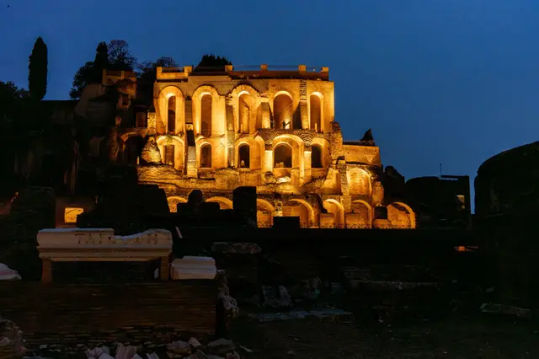
Rome’s 'Lost' Imperial Palace 'Domus Tiberiana' Reopens
Until recently a crumbling and off-limits ruin near the famous Colosseum, the Domus Tiberiana palace — built in the first century AD and beloved by Nero — hopes to once again take its place as one of the city’s top tourist attractions.
The ancient palace sits on Palatine Hill — the city’s oldest hill, overhanging Rome —from where imperial dynasties ruled for centuries. But over the years, the site fell into disrepair and in the 1970s, the Domus Tiberiana site was shut due to the structural instability of some of the ruins. The closure left behind what many Romans described as a “black hole” in the capital’s archaeological heart.
Now, after a six-year makeover, the palace has reopened its doors as a “diffuse museum,” with findings and frescoes scattered across the site to provide visitors with an insight into the palace’s ancient grandeur.
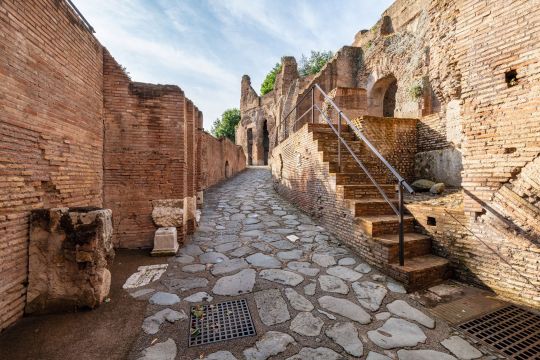
And it was grand. The Domus Tiberiana was Rome’s first imperial palace, built by the emperor Tiberius who combined and incorporated the pre-existing noble mansions built on the hill. Occupying over four hectares, the palace featured residences alongside large gardens, places of worship and rooms for the emperor’s Praetorian guard.
As the seat of Rome’s power and politics, Domus Tiberiana held a prime location, high above the Palatine and Roman Forums, offering its occupants a “balcony view of the city.” Over time, the Domus was embellished and enlarged by other emperors including Nero, who was crowned on its steps aged just 16, in 54 AD.
Alfonsina Russo, director of the Colosseum’s archaeological park (in which Domus Tiberiana falls) and lead archaeologist on the renovation, said that ancient antiquities, many exceptionally well-preserved, were unearthed during the project.
The artifacts — bright stuccos, frescoes, amphorae, potteries, looms, terracotta, and divinity statues related to the cults of Isis, Dionysius and Mithras — offer visitors a trip through time, said Russo.
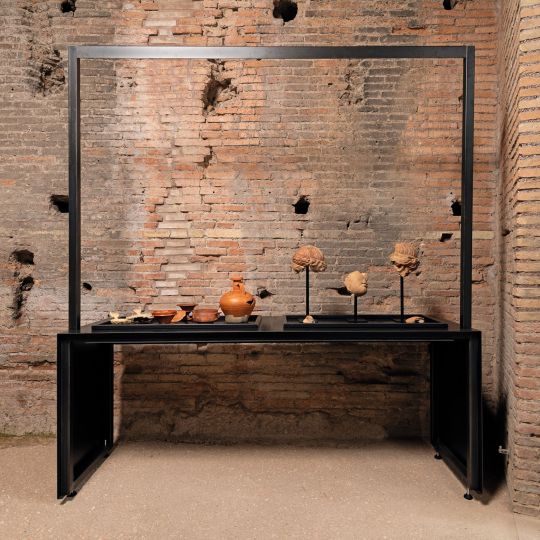
“They make this place — formerly (inhabited) by aristocratic families, then Roman emperors — feel alive again,” she said. “There are seven exhibition rooms full of extraordinary finds, starting with those preceding the original construction of the palace when aristocrats lived in mansions before Tiberius subsumed them into the Domus.”
Among the newly-exposed and frescoes are some of the earliest paintings of lemons (considered an exotic fruit in Ancient Rome, as they hailed from the Far East) and a depiction of a gladiator, proving that the era’s gladiatoral games were appreciated by rich families, explained Russo.
The imperial palace remained in use until the 7th century, when it became the papal residence of John VII. In the mid-16th century, the aristocratic Farnese family — who were powerful local landowners — built the lavish Orti Farnesiani gardens on the site, adorning it with ornaments and sculptures of nymphs, satyrs and fauns.
“This monument speaks of history,” Russo added. “We have restored (Domus Tiberiana) to its past splendor, but more work lies ahead.”
Indeed, painstaking efforts have been made to blend old and new. A series of majestic, reddish-brown vaulted arches that greet visitors having been carefully reconstructed with the same materials as ancient Romans used in the past.
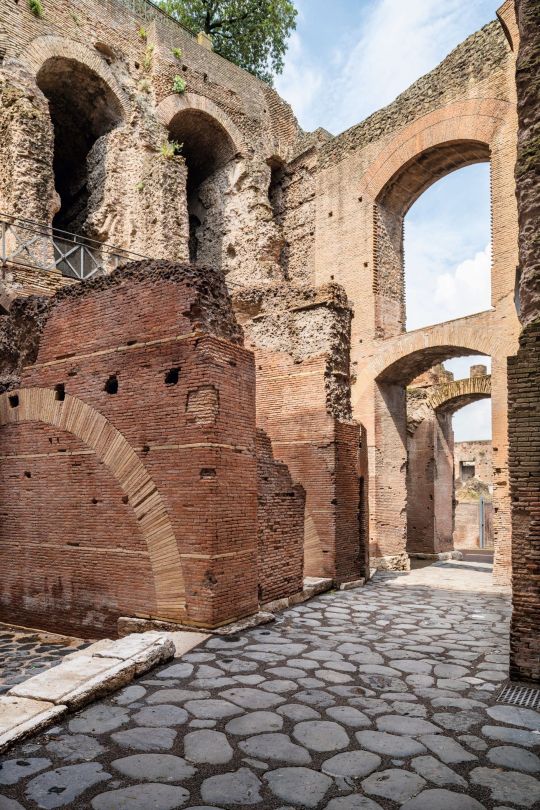

“What makes this revamped Domus unique is the architectural style,” said Russo. “We managed to use original materials to reinforce and strengthen the handmade 15-meter (50ft) tall front arches (which run alongside the palace’s) ancient paving.”
It has certainly caught the public’s attention. Since reopening at the end of September, Domus Tiberiana has attracted some 400,000 visitors, a “huge success,” said Russo, adding that she believes that this incarnation of the Domus Tiberiana offers visitors the most “evocative” visit in generations.
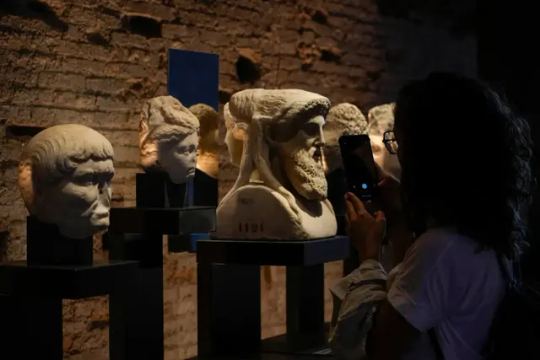
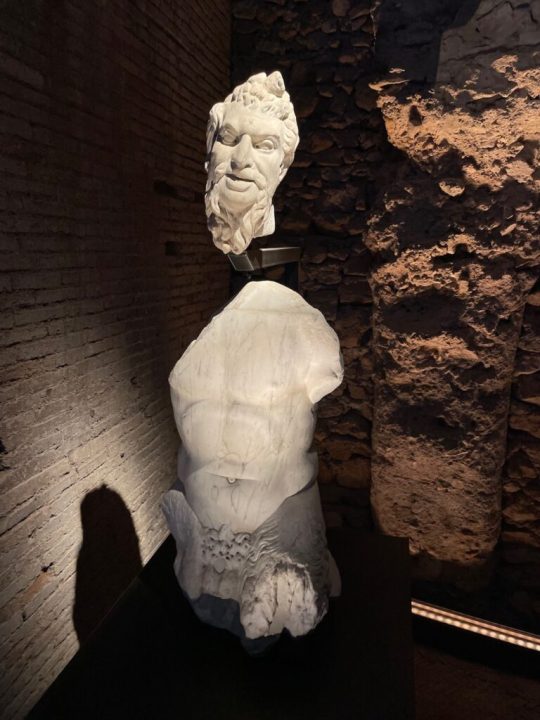
Archaeologist and scholar of ancient Rome Giorgio Franchetti saidN that, in the reopening of the Domus Tiberiana complex, Rome has “recovered a lost jewel.”
“The Palatine Hill has always been the stage of Rome’s power politics,” he said in an interview. “Tiberius likely chose this spot to build the palace as it was where his family residence stood. There aren’t many places like the Domus Tiberiana where you can really breathe the past.”
By Silvia Marchetti.



#Rome’s 'Lost' Imperial Palace 'Domus Tiberiana' Reopens#Domus Tiberiana palace#Palatine Hill#Emperor Tiberius#Emperor Nero#ancient artifacts#archeology#archeolgst#history#history news#ancient history#ancient culture#ancient civilizations#ancient rome#roman history#roman empire#roman emperor#roman art
274 notes
·
View notes
Text
Ok ok ok thoughts:
1. To me, the person leaving the baby at the pond looked like Alice, though I haven’t looked closely with the show paused to get a better look. I wonder who the other person was, too
2. Heartbreak hours for Katanna truthers 😔 God, that must have been so hard sending Kat away for her safety, knowing Susanna likes her enough to make that painting of her
3. That sweater Alice found is a Colton Landry sweater if ever I have seen one
4. I find it funny the brand Alice is doing her internship with has Queen of Cups as the logo bc that’s the card I keep face up on my tarot deck to remind me to bring the glasses out of my room
5. It’s Alice’s fault if the blazers in my closet get worn more often now. Oh my god it’s so devastating I had my hair cut to Kat length instead of keeping it at Alice length (whatever I’ll get over it no regrets)
6. GET IT DEL 😳😳😳👀👀👀🥵🥵🥵 lmfao
7. Who pushed Alice? Colton, needing her to go back to have the 1974 experience? Casey, who didn’t want Alice to know for sure they were using the pond?
8. It takes Del much too long and too much evidence to believe Colton wasn’t having an affair but it takes one handwritten page to convince her time travel is real and her family has been doing it.
9. Did Elliot get a record player for this season to play Colton (and Alice)’s demo or has that always been lurking in the background of his house in this show
10. Seeing Thomas on screen again was kinda whatever, nice to have that narrative closure but I don’t know how I ever was a coyleposter sorry
11. This is going to feel like one of the longest weeks of my life isn’t it
12. I wonder what Jacob will do with himself now that he might venture beyond the farm…? oh god I hope Monica and Rita leave him alone
13. I am patient. I can wait. I have serenity in my spirit WHAT DO YOU MEAN WE DIDNT GET THE SEE THE 1970s YET IN THIS EPISODE AAAAAAARRRGGHGHHRHRHHHHGHGH
31 notes
·
View notes
Text

DISSENT MAGAZINE
On March 27, President Donald Trump summarily overturned decades of federal labor relations policy and stripped more than 700,000 government workers of their union rights with a stroke of his sharpie. His executive order Exclusions from Federal Labor-Management Relations Programs, which effectively voided union contracts at dozens of departments and agencies, constitutes by far the largest and most aggressive single act of union-busting in U.S. history.
The stated rationale for Trump’s order—that the targeted workers are in agencies that affect national security and they therefore are ineligible for union representation—is flimsily transparent. Even the White House can’t sustain the lie. The administration’s own fact sheet points to the president’s real motivation. His order targets agencies whose unions “have declared war on President Trump’s agenda.” How have these unions “declared war”? Apparently, simply by attempting to enforce labor contracts and represent members in grievance proceedings. As the fact sheet notes, Veterans Affairs (VA) workers are losing their rights because their unions had the temerity to file “70 national and local grievances over President Trump’s policies since the inauguration.”
It is obvious that Trump is exacting revenge on unions that are challenging the draconian cuts and closures inflicted by Elon Musk’s renegade Department of Government Efficiency. Tellingly, unions believed to be sympathetic to the Trump agenda, such as those that represent federal law enforcement workers (whose work is more closely related to national security than that of, say, VA nurses or employees of the General Services Administration), have been exempted from his sweeping action.
The Radicalism of Trump’s Union-Busting
With his radical and blatantly political order, Trump, like a deranged Samson, is straining to pull down the solid pillars that have undergirded a remarkably stable system of federal labor relations for decades. If he succeeds, his action threatens many millions more than the federal employees directly affected by his executive order. As the nation’s largest employer, what the government does to labor inevitably ripples through the entire economy.
The only event in U.S. history comparable to Trump’s action is Ronald Reagan’s firing of some 11,500 striking air traffic controllers in 1981. Reagan’s crushing of the controllers’ union, PATCO, brought to a screeching halt the rapid expansion of public-sector unionization in the 1970s and catalyzed a wave of strikebreaking by private employers that set back the entire labor movement. In some ways, labor still struggles with the fallout of that fateful conflict. If Trump’s current action stands, its destructive force promises to be many orders of magnitude larger than the PATCO affair.
To grasp the enormous implications of Trump’s order, consider the elements of the time-tested structure that he is busy pulling down. The first pillar of the system was put in place in 1883 with the Pendleton Act, which created the federal civil service to professionalize those who worked in government and to end the spoils system that allowed the party in power to oust the personnel of federal agencies and install its supporters no matter their qualifications. Under the U.S. Civil Service Commission, federal workers freed themselves not only from fealty to corrupt political bosses but also from the status of at-will employees who can be fired for any lawful reason, or no reason—the condition under which most American workers, who lack union representation, operate to this day. As the civil service emerged, one of its central ideas was that its competent workers could not be fired without cause.
The second pillar of the system was put in place by the executive actions of a bipartisan line of presidents—Franklin D. Roosevelt, John F. Kennedy, and Richard Nixon—each of whom played a role in expanding federal workers’ collective bargaining rights with the government. The first step was taken by Roosevelt. In addition to signing the Wagner Act, which finally guaranteed most private-sector workers the right to unionize in 1935, he allowed a few federal agencies such as the Tennessee Valley Authority to bargain collectively with unions representing their tradesmen. Roosevelt’s experiment was seized upon and expanded by Kennedy. As Cold War imperatives made it unseemly for a government that claimed to lead the free world to deny its own employees any voice over the terms and conditions of their labor, Kennedy institutionalized collective bargaining for most federal workers by executive order in 1962. Seven years later, Nixon signed an executive order that further strengthened federal union rights and simplified the process through which workers chose union representatives.
(Continue Reading)
#politics#the left#federal government#progressive#progressive movement#democratic socialism#labor rights#labor unions#workers rights#organized labor#dissent magazine#federal workers
29 notes
·
View notes
Note
Can you explain the Iran-Israel situation please?
Alright, let's get to it. Please note that I'm writing this on mobile during my lunch break, so I can't include reference/source links as much as I'd like. Thankfully, most of what I'm going to be telling you should be easily located by searching for an article on one of the following: APNews, Reuters, BBC Global News Podcast, Democracy Now!, NPR, or The New York Times. Long-term background is probably best found in videos by the YouTube channels Real Life Lore or tldr global news, or on Wikipedia if you prefer text.
The short version: Israel attacked Iran's consulate in Syria to get at some of the military commanders that were there, which is legally equivalent to attacking Iran itself. Iran responded by sending about 300 bombs at Israel, most of which were shot down in transit. Given that they still called it a success, even though it seems only one person was even hurt, my understanding is that it's very likely that they only intended the rockets to be a show of force, rather than an actual escalation, because Iran can't afford a war right now.
To support my blogging so I can move out of my parents’ house, I do have a ko-fi. Alternately, you can donate to one of the charities I list in this post OR this post.
The long version:
Okay, let's start with some background on Israel, then Iran. This is... a lot, so if you already know the broad strokes skip down to 2023.
Israel was established following WWII by the English and French, following borders the two countries had secretly drawn up decades earlier in the Sykes-Picot agreement. The intent was to give the Jewish people a place to go... or, depending on who you ask, a place to send them. Their ancestral homeland was viewed as the best choice, sort of like a deportation millennia after a diaspora. Given that WWII had just ended by the time Sykes-Picot was actually put into effect, 'getting out of Europe' was something a lot of Jews were given to agree with.
The Arab world was not happy, as that land had belonged to the Ottomans for centuries, and had long since 'naturalized' to being Arab. I'm not going to pretend to know the nuances to when people do or do not consider Palestine to have been its own nation; it was an Ottoman state until WWI, at which point it came under British control for just under three decades, and that period is known as the British Mandate of Palestine; it ended after WWII, with the creation of Israel. Palestine's land and people have sort of just been punted around from one colonizer to another for centuries.
Iran is the current form of what was once Persia. They were an empire for a very long time, and were a unitary monarchy up until the early 20th century; in 1925, Iran elected a Prime Minister who was then declared the monarch. The following several decades had Iran's monarchy slowly weakened, and occasionally beset by foreign interventions, including a covert coup by the US and UK in 1953. The country also became more corrupt throughout the 1970s due to economic policy failing to control inflation in the face of rising oil prices.
In 1979, there was a revolution that overthrew the monarchy and the elected government, replacing the system with a theocracy and declaring Iran to be an Islamic Republic, with the head of state being a religious authority, rather than an elected one. This was not popular with... most countries. 1980 saw the closure of all universities (reopened in 1983 with government-approved curriculums), as well as the taking of over fifty American hostages from the US Embassy in Iran. You may have heard about that in the context of Ronald Reagan encouraging Iran to keep the hostages until the end of Carter's term in order to force the election.
So, the West didn't like having an Islamic state because it claims to like democracy, and also because the Islamic state was explicitly anti-American and this has some Bad Effects on oil prices. The Soviets didn't like having an Islamic State because a theocracy goes directly against a lot of communist values (or at least the values they claim to have), and weakened any influence their supposedly secular union could have on Iran and the wider middle east. The other countries in the Arab world, many of them still monarchies, didn't like the Islamic republic because if the revolution spread, then it was possible their monarchies would be overthrown as well.
(Except Oman, which is not worried, but that's the exception, not the rule.)
This is not a baseless worry, because Iran has stated that this is its goal for the Arab world. Overthrow the monarchies, overthrow the elected governments, Islamic Rule for everyone. That is the purpose of its proxies, like Hezbollah (Lebanon), the Houthis (Yemen), and Hamas (Palestine), along with less well-known groups like the Salafi Jihadists in Mali, who are formally under the umbrella of al-Quaeda, which Iran denies having any relation to but is suspected of funding. In areas where these proxy groups have gained power, they are liable to enact hard Shari'a law such as has happened in Northern Mali and other parts of the Sahel region.
While other conflicts have occurred in these countries, I think the above is most relevant.
Israel has repeatedly attacked, or been attacked by, other nations in the middle east, as they are viewed as having taken over land that is not theirs, and as being a puppet of the US government. The biggest conflicts have been 1947-1948, 1968/1973, and 2014.
And then, of course, 2023.
Now, Iran, more than any other nation in the Middle East, hates Israel. They have for a very long time, viewing them as an affront to the goal of spreading Islam across the whole of the middle east, and as being a front and a staging ground for the United States and other Western powers. Two common refrains in the slogans of Iran and its proxies are "Death to America" and "Death to Israel."
Due to Iran's military power and virulence towards Israel, the United States has been funneling money to Israel for decades. It has more generally been to defend itself against the Arab world at large, but it has narrowed over the decades to being about Iran and its proxies as relations have normalized with other nations like Egypt and Saudi Arabia.
Cue October 7th, 2023. Hamas invades Israeli towns, kills some people, and takes others as hostage. Israel retaliates, and the conflict ramps up into what is by now tens of thousands of dead, some half of which are children.
In this time, Hamas's allies are, by definition, Iran and the other proxy forces. Hezbollah, being in Lebanon, share a border with Israel's north. They have been trading rocket fire across the border in waves for most of the past six months. The Houthis, down in Yemen, claim to be attacking the passing cargo ships in order to support Palestine. Given that the attacks often seem indiscriminate, and that the Houthi's control over their portion of Yemen is waning in the face of their poor governance, this is... debatable. It's their official reason, but given that "let's attack passing ships, claiming that we only attack Israeli or American ships and that it is to support Palestine" is rallying support domestically for their regime, it does seem to be more of a political move to garner support at home than about supporting Palestine.
Iran, however, has not attacked Israel. They've spoken out about it, yes, but they haven't done anything because nobody wants a regional war. Nobody can afford it right now. Iran is dealing with a domestic crisis due to oil subsidies bleeding the states' coffers dry, and the aging Ayatollah Ali Khamenei, the leader of Iran, refusing to pick a successor. They are looking at both an economic crisis and succession crisis, and a regional war would fuck up both situations further. Iran funds most of its proxies, and they can't do that, and fight a war on top of it, while their economy is in its current state. Pure self preservation says they don't want a war, especially with the ongoing unrest that's been going on for... well, basically since the revolution, but especially since the death of Mahsa Amini.
Meanwhile, in Israel, Netanyahu has been looking at corruption charges and legal issues since before the Hamas attack. It's generally agreed that if Israel were to hold new elections right now, he would lose and be replaced, and also immediately taken to court. Netanyahu wants to stay in power, and as long as the war on Hamas lasts, he is unlikely to get voted out. A change in leadership in the middle of a war is rarely a good idea for any country, and he's banking on that.
However, the war on Hamas rests on the shoulders of American money and supplies. Without that military support, Israel cannot fight this war, and America... is losing patience.
Officially, America and most of the western world have been telling Israel to not fucking escalate for the majority of the war.
There have been implied threats, more or less since Schumer's big speech about how Israel needs a new election, of American legislators putting conditions on any future aid. There have even been rumblings of aid being retracted entirely if Israel follows through on invading Raffah.
So...
American aid to Israel has, for a very long time, been given in the name of defending Israel against Iran and its proxies.
Israel has been fighting this war against Hamas for six months, killing what is by now innumerable civilians, on the power of US military aid.
Netanyahu benefits from the continued war due to domestic troubles.
Iran does not want a regional war, or really any big war, due to its own domestic troubles.
The US is, in theory, losing patience with Israel and threatening to pull the plug on unconditional support. It's very "we gave you this to fight Iran. Stop attacking civilians. If you keep attacking civilians, then you're going to have to rely on what we already gave you to fight off Iran so that you won't keep wasting it on civilians."
Israel... attacks Iran, prompting a response, and is now talking about escalating with Iran.
I am not explicitly saying that it looks to me like Israel, which is already fighting a war on two physical fronts and even more political/economic ones, has picked a fight with Iran so that America feels less like it is able to withdraw support.
I just... am finding it hard to understand why Israel, which is in fact fighting both Hamas and Hezbollah, would attack the Iranian consulate in Syria otherwise. They can't actually afford to fight this war, escalating to a full regional conflict, on a third front.
Not without pressuring American into keeping the faucet of military funding open at full blast.
To support my blogging so I can move out of my parents’ house, I do have a ko-fi. Alternately, you can donate to one of the charities I list in this post OR this post.
#phoenix politics#current events#iran#israel#hamas#houthis#hezbollah#syria#politics#united states#military funding#military aid
98 notes
·
View notes
Text

Vera Lachmann (deceased)
Gender: Female
Sexuality: Lesbian
DOB: 23 June 1904
DOD: Died 1985
Ethnicity: Ashkenazi Jewish
Nationality: German
Occupation: Poet, teacher, classicist
Note 1: Founded a private school for children of Jewish and Jewish-Christian parents who had been expelled from public schools up until 1938. She then emigrated to United States in 1939.
Note 2: Founded Camp Catawba, a summer camp for boys in North Carolina. She directed the camp until its closure in 1970.
#Vera Lachmann#lgbt history#jewish history#lgbt#lgbtq#lesbianism#female#lesbian#1904#rip#historical#jewish#ashkenazi jewish#german#poet#writer#teacher
78 notes
·
View notes
Text
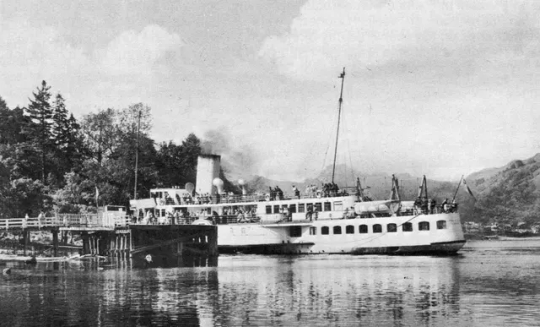


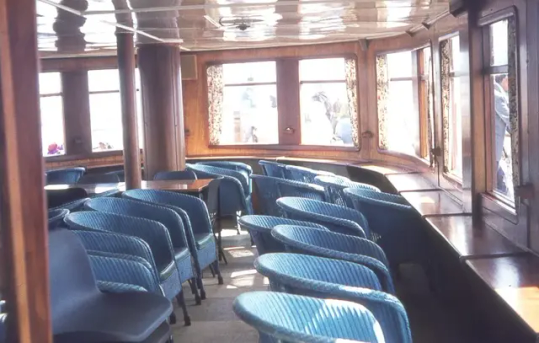



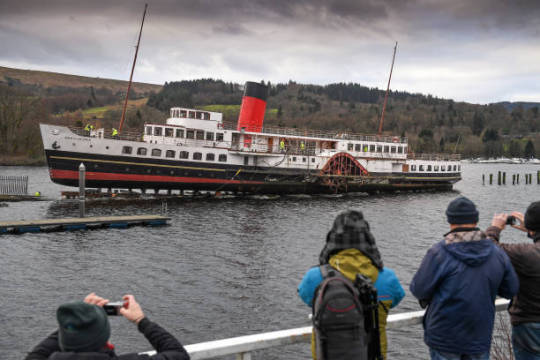

5th March 1953 saw The Maid of the Loch, the last Loch Lomond paddle steamer, lowered into the water.
On this day the historic ship left its Balloch base at 11.25am on its maiden voyage it took 1,000 passengers to Balmaha, Rowardennan, Tarbet, Inversnaid and Ardlui. For 28 years on, the Maid was known as the ‘heart’ of Loch Lomond, carrying millions of passengers, famous faces included, around the bonnie banks.
Ordered in 1950 by the British Transport Commission from A. & J. Inglis of Pointhouse, Glasgow, she was built and then cut into sections for transportation by rail to Balloch on Loch Lomond.
There she was re-assembled and was launched, almost complete, without ceremony. Her two-cylinder compound diagonal engine was built by Rankin & Blackmore of Greenock. She was painted white overall with green boot-topping, a buff funnel, and had the British Railways lion and wheel crest on her bows. In the 1975 season, her funnel colour was red with a black top. Her mainmast was removed in 1978. A service had first been initiated on Loch Lomond in 1818, and it is believed that this was the first regular passenger steamer service on an inland lake anywhere in the world.
The Maid was the twentieth paddle steamer to have sailed on Loch Lomond. She ran trials on 4 May 1953 and was named at a ceremony on 22 May, prior to a special cruise to Ardlui. The maiden cruise with fare-paying passengers took place on 25 May. Her regular route took her from Balloch to Ardlui with calls in either direction at Balmaha, Rowardennan, Tarbet and Inversnaid. From 1964, Maid of the Loch terminated at Inversnaid following the closure of the pier at Ardlui, though cruises to the Head of the Lake were also operated.
The Caledonian Steam Packet Company took over the ship in 1957, followed in 1969 by the Scottish Transport Group, and in 1970 by William Alexander & Sons - when the British Railways emblem was removed. The Maid fell on hard times as passenger numbers dwindled and the ship was eventually mothballed in 1981.
In 1992, he steamer was acquired by Dumbarton District Council and efforts to save the ship began with volunteer working parties; at the end of 1995, she was transferred to the Maid of the Loch Trust prior to the establishment of the Loch Lomond Steamship Company, a registered charity.
n 1997, her wooden deck was replaced with steel. Her lower hull was painted black, with ref boot-topping, above which the main deck sides and the superstructure remained white, but the funnel was now red with a black top. Following the restoration of the steam-powered slipway at Balloch, she was hauled out of the water in June 2006 (for inspection) for the first time since her withdrawal, as part of her rebuild - the objective of which is to return her to service.
This latest achievement was thanks to a £620,000 funding package from the Heritage Lottery Fund, Scottish Enterprise Dunbartonshire, West Dunbartonshire Council and LLSC. An internal refurbishment of the winch house, creation of a visitor interpretation facility and external landscaping is also planned.
In December 2018, the Scottish Government announced it had awarded a £950,000 capital grant. The Paddle Steamer Preservation Society also confirmed that a grant of £50,000 will still be granted, taking this working package to £1million. Funding will be spent on repairs to the vessel’s hull, creation of an education facility on board, refurbishing the main function suite and overhauling the engines to enable them to turn with steam.
Last year the old lady celebrated her 65th birthday as work continues on the restoration, and those of us in Scotland might recall her hitting the headlines in January this year.
The 65-year-old ship was being taken from the water ahead of restoration work when it slipped its ties and workers had to flee to safety. It was then taken back to its normal berth at Balloch Pier and the operation called off for the day.The Maid was berthed successfully the following day.
It’s a great wee train ride to Balloch from Glesga, and you can hop aboard the Maid of the Loch for free visit its Tea room and grab some souvenirs on board. Visitor displays and DVD shows; children’s activities; majestic steam engine. during the summer season. Work continues on board and you can witness the old steamer on its way to becoming a loch going ship. If you can’t make it check out their Facebook page for all the updates and pics from the past and present. Good luck and happy birthday The Maid of the Loch.
13 notes
·
View notes
Text

ALIENWORKS
Abandoned steelworks power plant.
This iron and steel factory is a former blast furnace cast iron factory, built in 1890 by a German family business. The factory specialized in the production of pig iron, made from local iron ore.

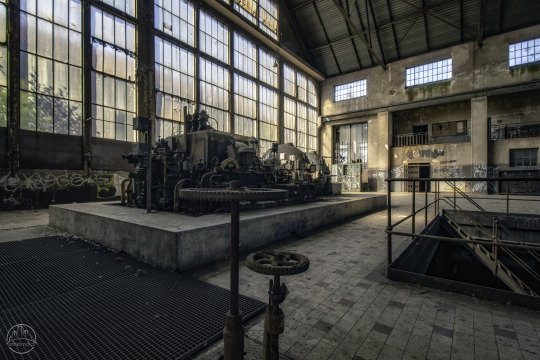

Thanks to the company's continuous modernization, its ideal location in the French steel basin and the restructuring of the steel industry, the company concentrated its entire production of French cast iron in the mid-1960s.


Despite all these favorable criteria and technical innovations, the company, like all other steel companies, suffered seriously from the crisis in the steel industry in the 1970s. The company managed to survive for a while, but was forced to announce its closure in the early 1990s.

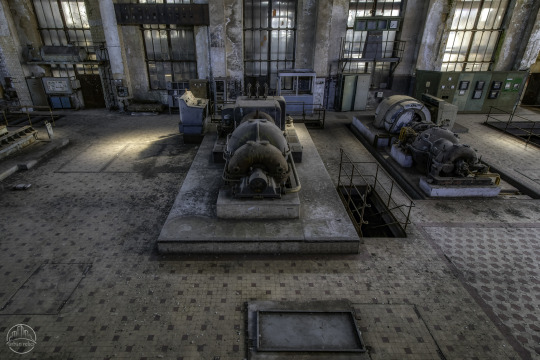
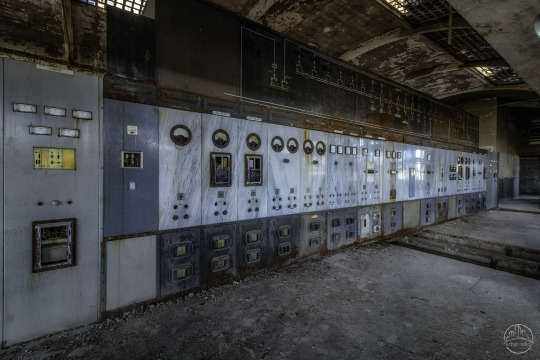

Part of the site, including the blast furnace itself, was preserved as industrial heritage.
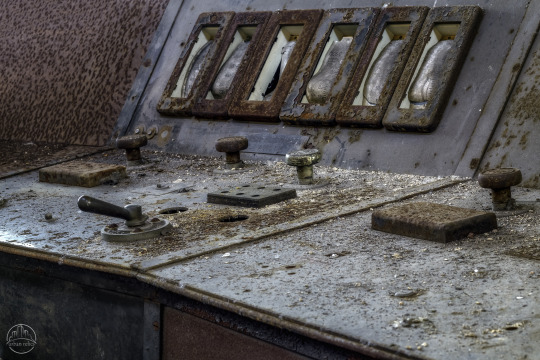

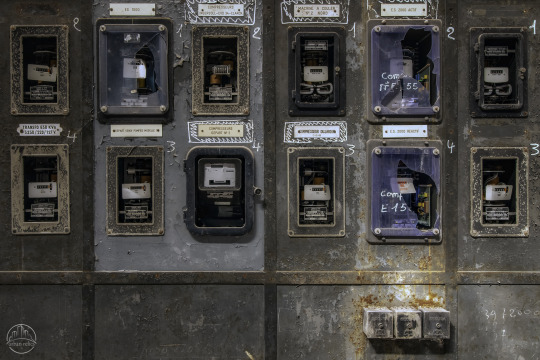
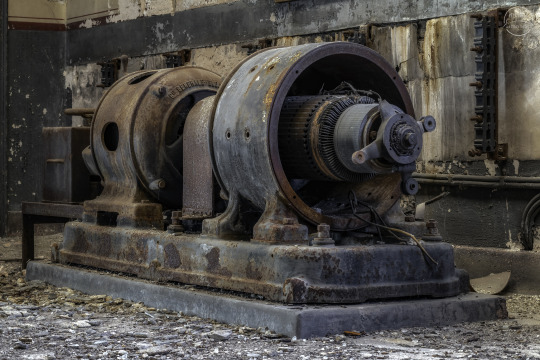
In this series of photos you see the power plant that was part of the blast furnace company. It is a classic power plant, with turbines from Brown Boveri and AEG, among others, driven by steam that was produced in the adjacent boiler room.
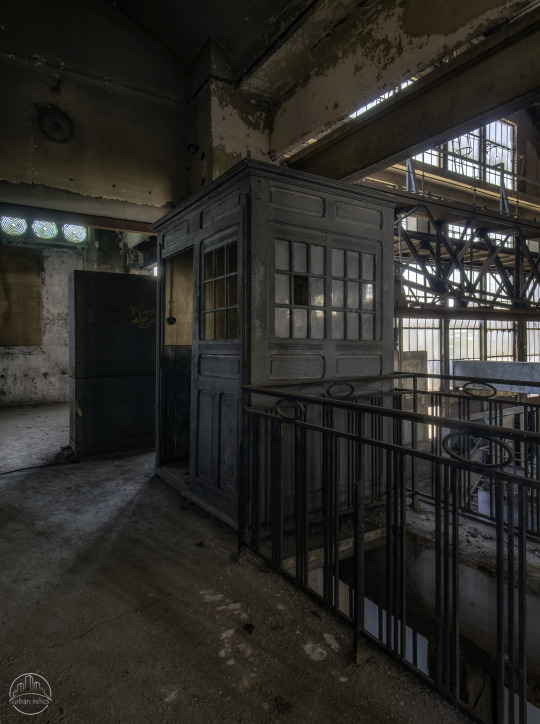

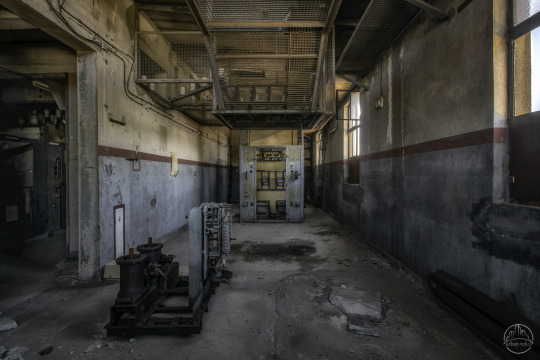
The site is well secured and difficult to access, which also explains why it has been preserved in its current beautiful state.

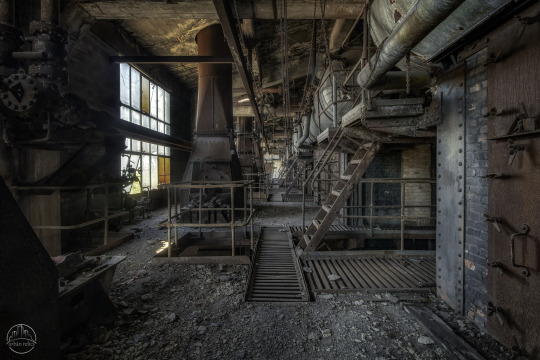

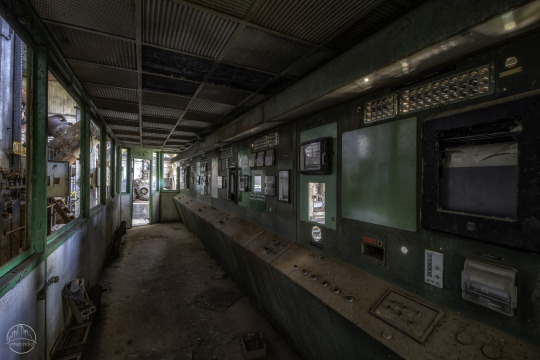
#urban exploration#urbex#abandoned#urban relics#decay#derelict#abandoned places#ue#urbexworld#urbexplaces#urbexphotography#abandoned buildings#industry#industrial#factory#power plant#alienworks#abandoned addiction#urbexpeople#france
78 notes
·
View notes
Text
Sonic Screwdriver prop history;
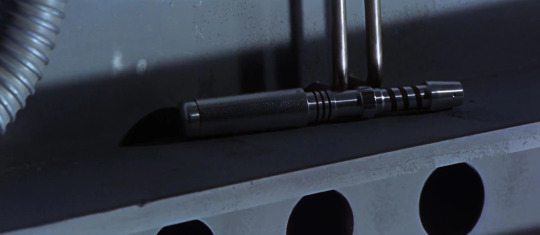


The Classic Series sonic screwdriver prop had it's origins in the 1966 film Thunderbirds are Go as the screwdriver Alan uses to repair the Zero-X escape unit. Following the closure of Century 21 studios in 1970, a number of props, including the screwdriver, were acquired by the BBC and the screwdriver became the Doctor's sonic screwdriver, making it's debut in 1971's Colony in Space.

In fact, the sonic screwdriver's emitter head had it's origins in Century 21 too, originally appearing as part of a radio mic in the Captain Scarlet & the Mysterons episode Model Spy in 1967.
#doctor who#sonic screwdriver#3rd doctor#4th doctor#thunderbirds 1965#captain scarlet and the mysterons
76 notes
·
View notes
Text
Tokyo court orders dissolution of ‘Moonies’ Unification church
Assassination of former Japanese PM Shinzo Abe spurred official request for closure of South Korea-based sect
Associated Press in Tokyo Tue 25 Mar 2025
A court in Japan has ordered the Unification church to be dissolved after a government request spurred by the investigation into the 2022 assassination of the former prime minister Shinzo Abe.
The church, founded in South Korea and nicknamed the “Moonies” after its late founder, Sun Myung Moon, is accused of pressuring followers into making life-ruining donations, and blamed for child neglect among its members, although it has denied any wrongdoing.
The church said it was considering an immediate appeal against the Tokyo district court’s revocation of its legal status, which would take away its tax-exempt privilege and require liquidation of its assets.
The order followed a request by Japan’s education ministry in 2023 to dissolve the influential South Korea-based sect, citing manipulative fundraising and recruitment tactics that sowed fear among followers and harmed their families.
The Japanese branch of the church had criticised the request as a serious threat to religious freedom and the human rights of its followers.
The church called the court order regrettable and unjust and said in a statement that the court’s decision was based on “a wrong legal interpretation and absolutely unacceptable”.
The investigation into Abe’s assassination revealed decades of cosy ties between the church and Japan’s governing Liberal Democratic party. The church obtained legal status as a religious organisation in Japan in the 1960s during an anti-communist movement supported by Abe’s grandfather, the former prime minister Nobusuke Kishi.
The man accused of killing Abe resented the church and blamed it for his family’s financial troubles.
The church, which officially calls itself the Family Federation for World Peace and Unification, is the first religious group subject to a revocation order under Japan’s civil code. Two earlier cases involved criminal charges: the Aum Shinrikyo doomsday cult, which carried out a sarin nerve gas attack on the Tokyo subway system; and Myokakuji group, whose executives were convicted of fraud.
Seeking the church’s dissolution, the education ministry submitted 5,000 documents and pieces of evidence to the court, based on interviews with more than 170 people.
The church used manipulative tactics to make its followers buy expensive goods and donate beyond their means, causing fear, harm and seriously deviating from the law on religious groups, officials and experts said.
The cultural affairs agency said the settlements reached in or outside court exceeded 20bn yen (£103m) and involved more than 1,500 people.
The church, founded in Seoul in 1954, a year after the end of the Korean war, by Moon, a self-proclaimed messiah who preached new interpretations of the Bible and conservative, family-oriented value systems.
It developed relations with conservative world leaders including the US president, Donald Trump, as well as his predecessors Richard Nixon, Ronald Reagan and George HW Bush.
The church faced accusations in the 1970s and 1980s of using devious recruitment tactics and brainwashing adherents into turning over huge portions of their salaries to Moon. In Japan, the group has faced lawsuits for offering “spiritual merchandise” that allegedly caused members to buy expensive art and jewellery or sell their real estate to raise money for the church.
The church has acknowledged excessive donations, but says the problem has lessened since the group stepped up compliance in 2009.
Experts say Japanese followers are asked to pay for sins committed by their ancestors during Japan’s 1910-45 colonial rule of the Korean peninsula, and that most of the church’s worldwide funding comes from Japan.
________________________________
However, the Church will still be able to continue religious practices, lawyer Katsuomi Abe said. "Its reputation will decline, and the number of followers will decrease", said Abe, who represents former believers seeking compensation after making huge donations.
"I don't think any other organisation has caused such damage" to Japanese society, he told AFP.
________________________________
A huge Moon Church scam in Japan is revealed
Shocking video of UC of Japan demanding money – English transcript
Top Japanese ex-UC leader, Yoshikazu Soejima, interviewed
Moon extracted $500 million from Japanese female members
Court: "UC/FFWPU of Japan used members for profit, not religious purpose
How Sun Myung Moon bought protection in Japan 1a. The LDP’s Tangled Ties to the Unification Church (2022) 1b. NNLASS press conference held in Tokyo on FFWPU/UC “spiritual sales” (2022)
Richard J. Samuels – Kishi and Corruption: An Anatomy of the 1955 System (2001)
Parents Form Organization Against New-Religious Sect (1976)
John Roberts – Earth-conquering Moonies (1978)
Kishi wrote a letter to President Reagan to get Moon sprung from jail. (1984)
#unification church#sun myung moon#hak ja han#family federation for world peace and unification#cult#extortion
12 notes
·
View notes